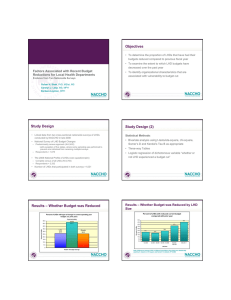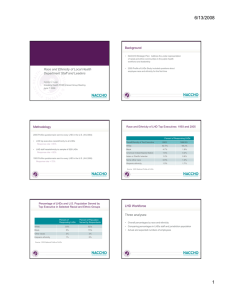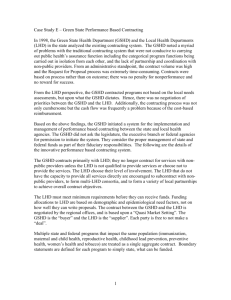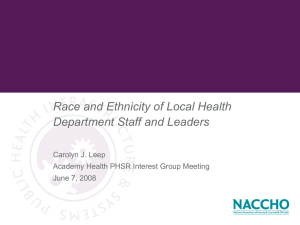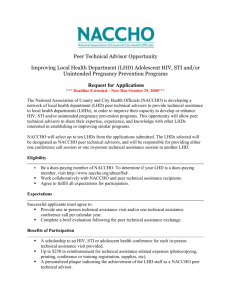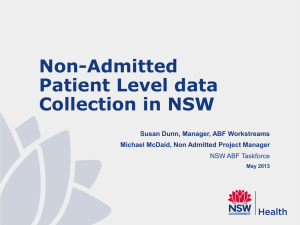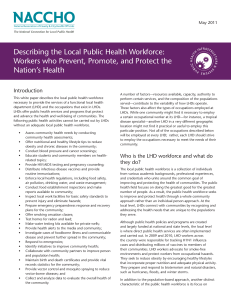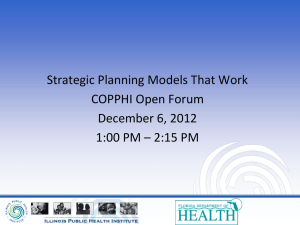Revenue generation as budget strategy
advertisement
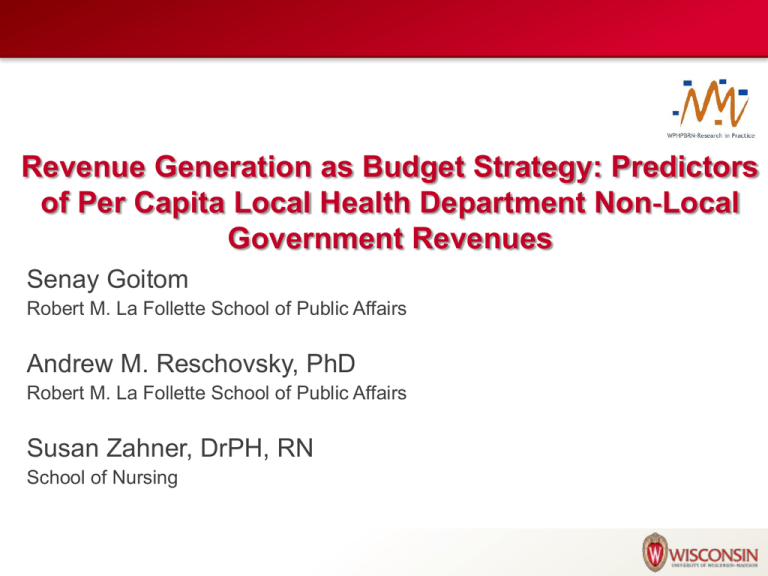
Revenue Generation as Budget Strategy: Predictors of Per Capita Local Health Department Non‐Local Government Revenues Senay Goitom Robert M. La Follette School of Public Affairs Andrew M. Reschovsky, PhD Robert M. La Follette School of Public Affairs Susan Zahner, DrPH, RN School of Nursing Acknowledgments • Support for this research was provided by a grant from the Robert Wood Johnson Foundation’s Public Health Practice-Based Research Networks program, and • A Health Policy Assistantship funded by grant #1UL1RR025011 from the Clinical and Translational Science Award program of the National Center for Research Resources, NIH Effect of Economic Crisis on LHDs Housing collapse and “Great Recession” have led to steep budget cuts at all levels of government In Wisconsin, as in many other states, recent budget deficits have been closed primarily through cuts in spending In Wisconsin, constraints have been placed on LHDs in the form of property tax levy limits This will impact the single largest source of revenue for LHDs Rationale Given the constraints facing local governments, non-local government sources will become increasingly important This study represents a first step in understanding the factors affecting these revenue sources Local Health Departments in WI In Wisconsin, 94 LHDs provide public health services including: Communicable disease control • Immunization • Investigation of disease outbreaks • Education Chronic disease prevention and control • Wellness programs Environmental health • Water testing • Restaurant and lodging inspections Research Question What community and LHD characteristics affect growth of non-local government revenue? Description of Data Panel dataset 92 health departments • Representing 70 counties and 42 municipalities 2002-2009 Total panel size N=746 Includes data from the following sources: Wisconsin Department of Health Services Local Health Department Survey (2002-2009) • LHD Revenue Data • Local Health Department Inventory • Data on Services Provided Demographic Data Wisconsin Department of Revenue • Equalized Property Value Data • Property Tax, Sales Tax, Shared Revenue Data Local Health Department (LHD) Financing in Wisconsin In Wisconsin, LHDs receive revenue from the following sources: County/municipal sources (e.g. taxes) Fees for services Federal grants State grants Private grants Donations from individuals Focus of this presentation Sources of Non-Local Government Revenue Fees for services Restaurant and private well inspections Medicare and medicaid reimbursements Federal Grants Maternal and Child Health Block Grant WIC State grants Childhood lead Well Woman programs Private grants Donations from individuals Percent of Total Revenue 2002-2009 Share of Total Revenue (%) mean SD min max Tax Revenue 51.4 16.1 0 100 Federal Grants Fee for Services 21.8 17.8 12.4 11.6 0 0 75.7 61.1 State Grants 7.5 7.3 0 53.9 Private Grants 1 2.3 0 26.5 Donations 0.4 2.3 0 46.1 Regression Model We are looking at why some health departments are obtaining more revenue than others ln 𝑅𝑒𝑣 = 𝛽0 + 𝜷𝟏 𝑿𝟏 + 𝜷𝟐 𝑿𝟐 + 𝜹𝒀𝒆𝒂𝒓 + ε Where: 𝑅𝑒𝑣 is non-local government sources of revenue 𝑿𝟏 is a vector of community characteristics 𝑿𝟐 is a vector of LHD characteristics 𝒀𝒆𝒂𝒓 corresponds to a vector of time dummy variables Estimation Method Log transformation where appropriate (dependent variable and some RHS variables) Lag structure Include one and two year lagged values of dependent variable Pooled OLS regression Robust standard errors using LHDs as clusters Summary Statistics of Variables in Final Model mean sd min max Per capita non-local government revenue 13.58 9.29 0.00 90.78 LHD population (1000s) 59.91 81.45 4.59 595.96 Per capita personal income (1000s) 34.03 5.32 21.00 62.16 Per capita EQV (1000s) 87.36 42.70 35.45 359.99 Under-18 poverty (%) 15.26 6.93 2.70 51.10 Over 65 (%) 14.69 3.34 9.16 26.04 County health ranking (z-score) 0.13 0.86 -1.73 3.00 Share of total services (%) 50.90 13.42 6.57 78.20 Majority of BOH non-elected (0,1) 0.43 - 0 1 DHS inspection agent (0,1) 0.59 - 0 1 Regression Results-Community Characteristics Full Model No Lags Final Model (with lags) county unemp. rate -0.0189 (0.0281) -0.0546 (0.0667) county poverty rate 0.0227 (0.0200) 0.0587* (0.0335) county under 18 pov. -0.0264** (0.0123) -0.0680*** (0.0205) -0.0121** (0.0049) county health ranking 0.0730* (0.0409) 0.0686 (0.0677) 0.0512* (0.0287) per capita EQV 0.0550 (0.0925) 0.1207 (0.1638) 0.0697 (0.0542) per capita pers. inc. -0.5319** (0.2612) -1.6301*** (0.5314) -0.3148* (0.1733) county pop. non-white 0.0006 (0.0038) 0.0010 (0.0083) county pop. under 20 0.0025 (0.0125) -0.0081 (0.0272) county pop. 65+ 0.0182 (0.0135) 0.0451 (0.0286) 0.0058 (0.0061) Standard errors in parentheses * p < 0.10, ** p < 0.05, *** p < 0.01 Regression Results (cont’d)-LHD Characteristics Full Model Local gov’t GPR No Lags 0.0177 (0.0654) Non-local gov't rev. (L1) 0.4558*** (0.0801) 0.4702*** (0.0722) Non-local gov't rev. (L2) 0.2369*** (0.0383) 0.2438*** (0.0348) LHD population -0.1006** (0.0490) -0.2800*** (0.0935) -0.0811** (0.0349) pct of tot LHD services 0.0054*** (0.0017) 0.0187*** (0.0030) 0.0054*** (0.0017) Indp LHD indicator 0.0176 (0.0589) 0.0282 (0.1403) County LHD indicator -0.0362 (0.0816) 0.0732 (0.2138) BOH non-elect. Indicator 0.0333 (0.0387) 0.1529 (0.1000) 0.0191 (0.0288) Indp BOH indicator -0.0223 (0.0564) -0.0549 (0.1414) DHS inspec agnt indicator 0.0569 (0.0359) 0.1403 (0.0995) 0.0622** (0.0288) Constant 4.3313 (4.9239) 17.2202** (7.8844) 3.8235** (1.7124) Observations Adjusted R2 Standard errors in parentheses * p < 0.10, ** p < 0.05, *** p < 0.01 406 0.722 -0.0438 Final Model (with lags) 414 0.543 (0.1282) 412 0.734 Interpretation of Regression Coefficients Variable Unit change Percent change in non local government revenue Under 18 poverty rate +1 percentage point -1.2% County Health Ranking + one standard deviation +5.2% Per capita personal income +1% -0.3% Non-local government revenue (lagged one year) +1% +0.5% Non-local gov’ t revenue (lagged two years) +1% +0.2% LHD population +1% -0.08% % of total services +1 percentage point +0.5% LHD is DHS Inspection Agent N/A +6.4% Policy Implications Two variables point to possible strategies for health departments Percent of total services Whether the LHD is an agent of DHS The model suggests that changes that increase the number of services provided by LHDs have a positive, statistically significant association with revenue Contact information Senay Goitom goitom@wisc.edu 312-520-7115 Andrew Reschovsky reschovsky@lafollette.wisc.edu 608-263-0447 Susan Zahner sjzahner@wisc.edu 608-263-5282

